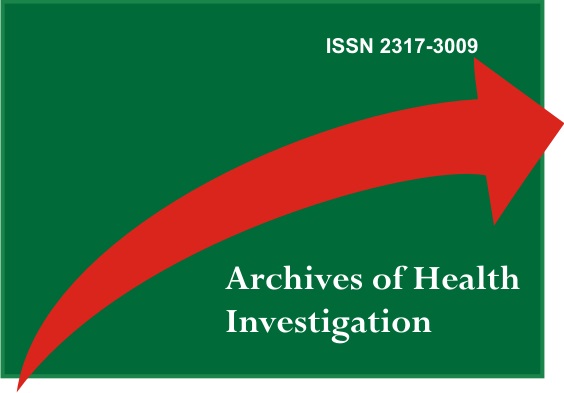Is Acupuncture effective in the treatment of temporomandibular disorders? A literature review
DOI:
https://doi.org/10.21270/archi.v10i9.5258Keywords:
Acupuncture, Acupuncture Therapy, Facial Pain, Temporomandibular Joint Dysfunction SyndromeAbstract
Temporomandibular disorder (TMD) is a group of conditions that present pain in the temporomandibular joint (TMJ) region as a symptom. The etiology of this condition is still uncertain, but it is suggested as multifactorial. The main focus in the treatment of TMD is the control of pain, and the dysfunction of the masticatory apparatus in order to mitigate adverse loads that end up perpetuating the problem. Acupuncture is part of Traditional Chinese Medicine, a technique that basically consists of introducing needles at specific points on the body surface, and has been used to promote pain relief. This study aimed to evaluate the use of acupuncture in the treatment of TMDs. A literature review was carried out with search in the databases PubMed, Lilacs, Medline and BBO in the period from 2000 to 2020 so that 53 articles were found. Thirty seven articles were excluded after reading titles and abstracts, including 16 articles. From the researched literature, it can be concluded that acupuncture is a complementary supportive therapy in the treatment of temporomandibular disorders and has been shown to be as efficient in controlling facial pain as conventional therapies.
Downloads
References
Barnes JF. Electronic acupuncture and cold laser therapy as adjuncts to pain treatment. J Craniomandibular Pract. 1984;2(2):148-52.
Bergström I, List T, Magnusson T. A follow-up study of subjective symptoms of temporomandibular disorders in patients who received acupuncture and/or interocclusal appliance therapy 18-20 years earlier. Acta Odontol Scand. 2008;66(2):88-92.
Buescher JJ. Temporomandibular joint disorders. Am Fam Physician. 2007;76(10):1477-82.
Ferreira LA, de Oliveira RG, Guimarães JP, Carvalho AC, De Paula MV. Laser acupuncture in patients with temporomandibular dysfunction: a randomized controlled trial. Lasers Med Sci. 2013;28(6):1549-58.
Gonzalez-Perez LM, Infante-Cossio P, Granados-Nuñez M, Urresti-Lopez FJ. Treatment of temporomandibular myofascial pain with deep dry needling. Med Oral Patol Oral Cir Bucal. 2012;17(5):e781-85.
Hotta PT, Hotta TH, Bataglion C, Bataglion SA, de Souza Coronatto EA, Siéssere S, et al. Emg analysis after laser acupuncture in patients with temporomandibular dysfunction (TMD). Implications for practice. Complement Ther Clin Pract. 2010;16(3):158-60.
Hunter EK. Integration of rehabilitation and acupuncture in the treatment of a professional musician with temporomandibular joint dysfunction. Acupunct Med. 2011;29(4):298-301.
Katsoulis J, Ausfeld-Hafter B, Windecker-Gétaz I, Katsoulis K, Blagojevic N, Mericske-Stern R. Laser acupuncture for myofascial pain of the masticatory muscles. A controlled pilot study. Schweiz Monatsschr Zahnmed. 2010;120(3):213-25.
Ritenbaugh C, Hammerschlag R, Dworkin SF, Aickin MG, Mist SD, Elder CR, et al. Comparative effectiveness of traditional Chinese medicine and psychosocial care in the treatment of temporomandibular disorders-associated chronic facial pain. J Pain. 2012;13(11):1075-89.
Rosted P. Introduction to acupuncture in dentistry. Br Dent J. 2000;189(3):136-40.
Rosted P, Bundgaard M, Pedersen AM. The use of acupuncture in the treatment of temporomandibular dysfunction--an audit. Acupunct Med. 2006;24(1):16-22.
Rosted P, Jørgensen V. Acupuncture treatment of pain dysfunction syndrome after dental extraction. Acupunct Med. 2002;20(4):191-92.
Schmid-Schwap M, Simma-Kletschka I, Stockner A, Sengstbratl M, Gleditsch J, Kundi M, et al. Oral acupuncture in the therapy of craniomandibular dysfunction syndrome -- a randomized controlled trial. Wien Klin Wochenschr. 2006;118(1-2):36-42.
Shen YF, Goddard G. The short-term effects of acupuncture on myofascial pain patients after clenching. Pain Pract. 2007;7(3):256-64.
Shin BC, Ha CH, Song YS, Lee MS. Effectiveness of combining manual therapy and acupuncture on temporomandibular joint dysfunction: a retrospective study. Am J Chin Med. 2007;35(2):203-8.
Simma I, Gleditsch JM, Simma L, Piehslinger E. Immediate effects of microsystem acupuncture in patients with oromyofacial pain and craniomandibular disorders (CMD): a double-blind, placebo-controlled trial. Br Dent J. 2009;207(12):E26.
Smith P, Mosscrop D, Davies S, Sloan P, Al-Ani Z. The efficacy of acupuncture in the treatment of temporomandibular joint myofascial pain: a randomised controlled trial. J Dent. 2007;35(3):259-67.
Okeson JP. Tratamento das desordens temporomandibulares e oclusão. 6. ed. Rio de Janeiro: Elsevier; 2008.


